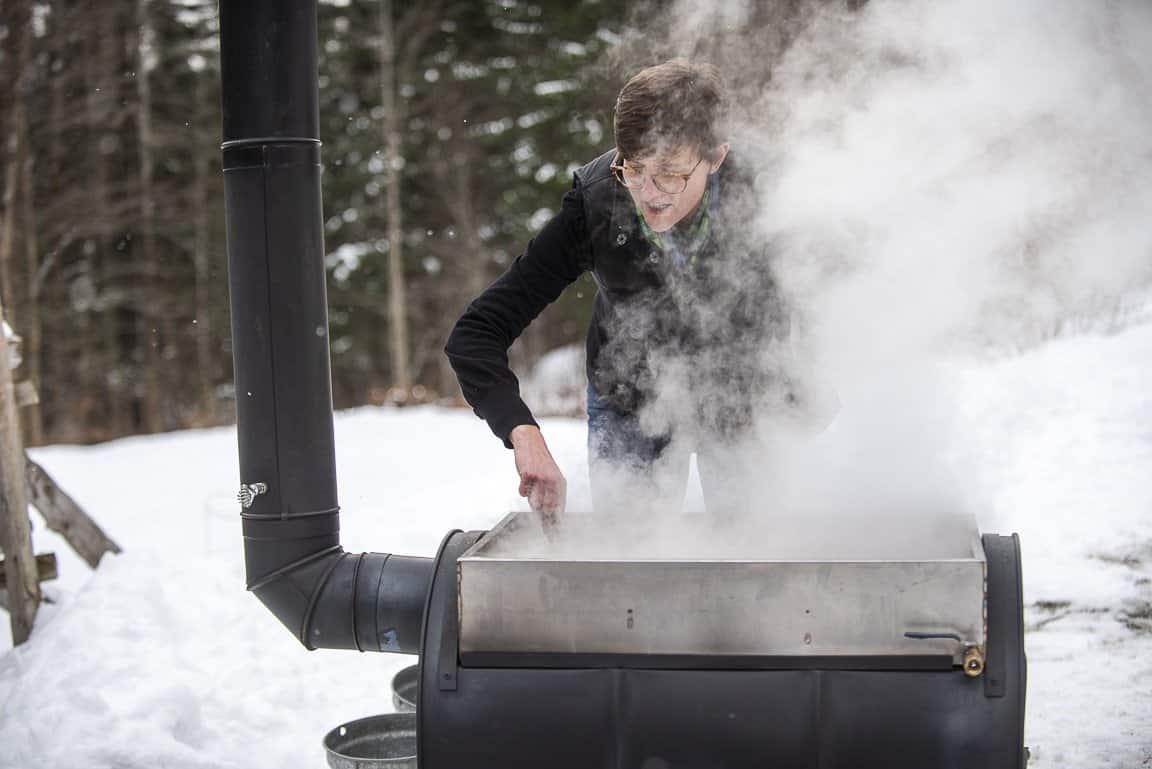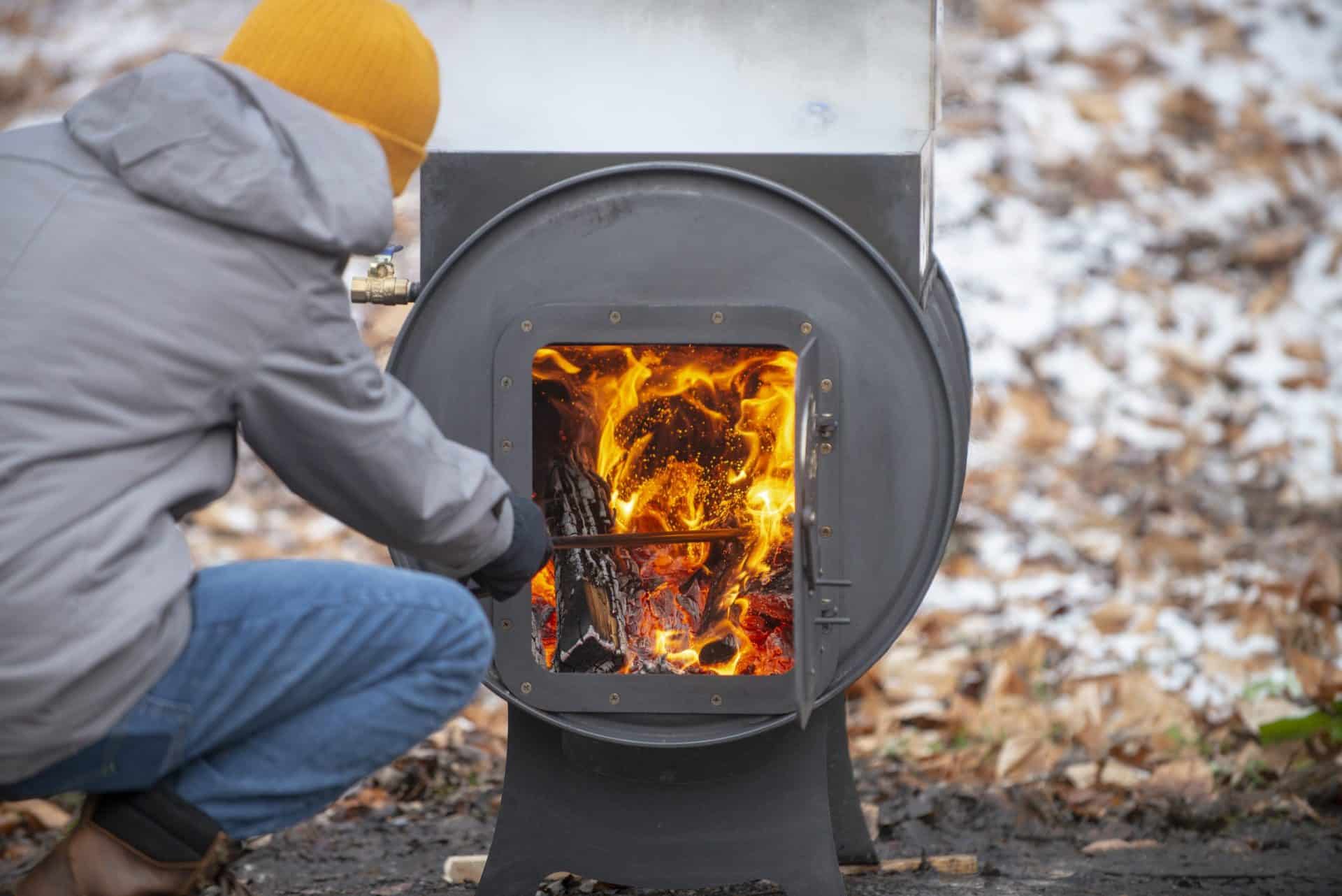You’ve tapped your maple trees. You have been collecting and storing sap. The weekend approaches. It’s time to boil down, finish, filter and store some maple syrup! Here’s how!
Making Maple Syrup is Simple
Making maple syrup is a simple process that involves removing most of the water from maple sap—a weak sugar solution with a unique mix of minerals—through evaporation. While maple syrup sold commercially is of a very precise sugar concentration, those of us who make syrup for subsistence and gifting don’t generally worry about that level of precision. Like the proverbial horseshoes (subject to the below) with DIY maple, close often really does count.
Evaporation Requires Heat and a Vessel
All you need to reduce sap to syrup is a cooking vessel and a heat source. It takes 40 gallons of sap from a sugar maple to make a gallon of maple syrup, and can take more than 60 gallons of sap from a red, silver or other maple to make a gallon of syrup, so it’s best to bring some patience as well.
There are now commercially available hobby evaporators for the backyard sugar maker. These units come with instructions and, if we do say so ourselves, are a great choice for beginners. While you may find homemade units online, naturally, we have a lot to say about the benefits of our products. If you aren’t interested in investing at all in specialized equipment, though, that’s really ok! Many of us simply start out putting together heat-source-cooking-vessel combinations from things we already own or can acquire on the cheap. Options abound! But some guidance is in order.
First, we suggest you abandon any plans involving the great indoors (pasta pot on stovetop or kettle on parlor stove) because of the mess it makes in your living space (sticky cabinets and peeling wallpaper). Outdoor cooking methods avoid this problem, and also . . . get you outdoors.
Second, think about your heat source. Wood is a great fuel for sugaring; with wood, you can make a very hot fire at a very low cost; you can sugar with wood of a different quality than what you burn in your house. Wood fires can be messy, though, and, unless you enclose the fire and direct the smoke away from your boil, your syrup may end up tasting a bit like bacon. That doesn’t bother everyone, but for those looking to avoid it, there are many common options, including converting old wood stoves, oil tanks, barrels or even file cabinets (truth!) into an enclosed firebox. Others include assembling cinder blocks or bricks and stovepipe into enclosed, outdoor fireplaces.
Propane is a tidy, but slower and more expensive heat source. If you are using propane, opt for high-BTU burners like turkey fryers rather than using your propane grill, and be sure to protect your flame from the wind by situating yourself in a windbreak or “bricking in” your flame as you would a wood fire. And then prepare to buy a lot of propane.
Third, choose your vessel. If you have purchased a special sugaring pan (yes we sell those too) it should come with instructions. These pans are handy because they are engineered for efficiency. If you haven’t purchased such a pan, when choosing a cooking vessel from your collection, keep in mind that the more surface area you have, the faster your boil will go. So, tall and thin brew pots are not as good of a choice as, say, the broiling pan for your thanksgiving turkey, for example. Many first-timers invest in one or more stainless steel buffet pans to maximize surface area while minimizing expense.

From Sap to Finished Syrup
Now that you have a heat source and a cooking vessel, you can make maple syrup! To start, situate your pan over your heat source, put some sap in it, light your fire, and bring your sap to a boil. Boil some more. Next, boil. Then, keep boiling. Finally, boil some more. (Get the idea?) You will notice the sap level drop, and the sap itself becoming darker in color, thicker, and sweeter to the taste. Depending on the volume of sap you have collected relative to the capacity of the vessel you have chosen, you may put all your sap in the vessel at once and boil it all down to syrup in one go, you may put some of your sap in the vessel and add more sap to your boil throughout the day, or you may run two or more vessels at once, boiling from raw sap to sweetened sap in one or more vessel(s), and from sweetened sap to syrup in another. If you have a specialized sugaring pan, you will be adding more sap to your pan continuously.
Whatever method you choose, keep boiling until what you have acts, tastes and looks like syrup. You can be as precise as you wish: undercooked syrup tastes just fine, but does not have as long of a shelf life; overcooked syrup is sugar, which tastes even better but, if achieved by accident, can lead to burnt pans and large messes, heartbreak and gnashing of teeth. For an analog test, drizzle a bit of your boil on a cold plate and see if it acts like syrup, or dunk a spatula in your syrup and see if it comes off in a sheet (syrup) or drops (not yet). For more precision, take a temperature reading: syrup boils at about 7 degrees above water, so a boiling solution that measures about 219 degrees is syrup. Having never had luck with our own cheap candy thermometer, we highly recommend a maple syrup finishing thermometer for measuring syrup. You can check to see if you have achieved professional precision by taking a Brix reading with a syrup hydrometer.
A note about wood: many who make maple syrup using wood heat choose to draw off a bit early into another pot or pan and finish on, for example, a propane burner outside, or on the kitchen stove inside. This is because those methods allow us to better control the heat (wood heat is hard to regulate) and better monitor the temperature (high quality thermometers need several inches of fluid to give a reliable reading) to ensure that we do not overcook. Once you are at the finishing stage, it’s fine to bring your boil inside; at that point, you’ll make no more mess of your house, generally, than you would making pasta.
Filtering, Storing and Grading Syrup
Not everyone filters their homemade maple syrup. If you are making for home consumption and don’t mind finding sugar sand (concentrated minerals) at the bottom of your jars, you can skip this step! If you intend to gift syrup in pretty bottles, are a perfectionist, or otherwise inclined to filter, having the right supplies really helps. If you intend to filter and purchase nothing else your first time around, get yourself a syrup filter and two pre-filters. Take it from us: this will be a giant improvement on using coffee filters (slower than slow), cheesecloth (lets everything through), or something you’ve rigged up using dish towels and your applesauce maker (mess, trauma, disaster). Layer the two pre-filters inside the filter and place in an appropriately sized, food-safe receptacle (stock pot, brew pot, pitcher). Pour your syrup through the layers, taking each pre-filter out as it gets hopelessly gunked up. (Don’t throw them away; pre-filters can be rinsed out and used multiple times, as can filters proper.) The hotter the syrup is going into the filters, the faster this goes.
Have your jars clean and at the ready, just as you would if canning. There are plenty of fancier options out there, but glass canning jars with new lids work fine. No matter what you choose, make sure that your syrup is at least 180 degrees going into the jar. If it isn’t, heat it up to between 180 and 200 before canning. Once the jar or bottle is full (with 1/4 inch head room) and the lid secure, let cool and store for up to two years on the shelf. Resist the temptation to can your syrup by boiling in a hot water bath; it is unnecessary and you may end up with intractable rock candy at the bottom of your jar.
Wondering what grade of syrup you made? Impress your friends and family by using a grading kit to find out whether it’s golden, amber, dark or very dark! And know that, whatever the grade, it’ll be the most delicious syrup you’ve ever tasted.
Happy Sugaring!

